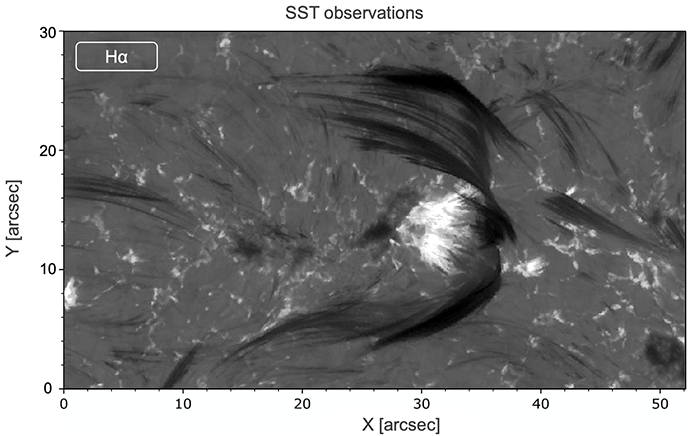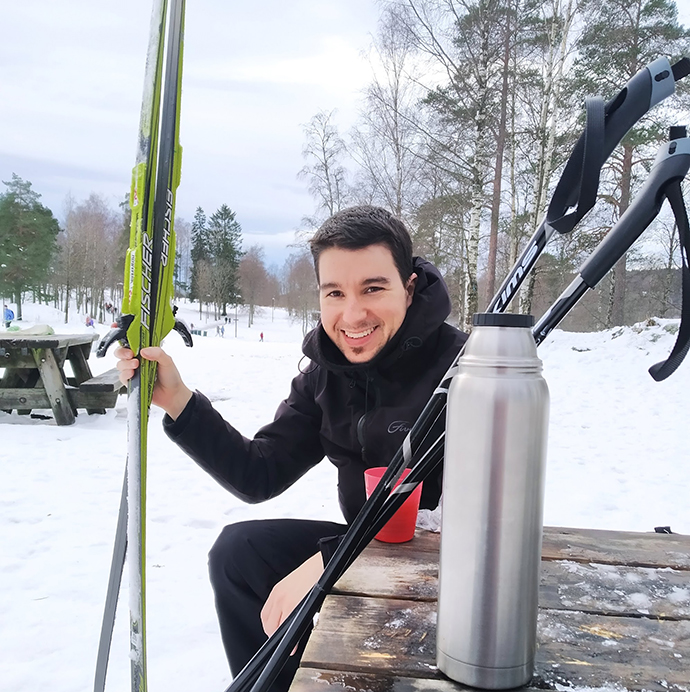Carlos joined the RoCS research team in October 2022, and he enjoys working at RoCS which he finds to be "a unique place".
He did his Bachelor's degree in Physics, followed by a Master's degree in Astrophysics, and a Ph.D. in Solar Physics, all at the University of La Laguna and the Instituto de Astrofísica de Canarias in Spain.
- Upon successfully defending my Ph.D. thesis, I embarked on an exciting journey as a postdoctoral researcher at the Institute of Solar Physics at Stockholm University, where I spent four fruitful years, Carlos explains.
Solar filaments in detail
-What have you studied before?
- During my Ph.D. and first postdoc, my research focused on understanding solar chromospheric phenomena and their magnetic origin by analyzing spectropolarimetric observations.
During my Ph.D. I studied in detail one of the most fascinating phenomena of the Sun, solar filaments.
With current instrumentation, computing power, and a consolidated theory of the generation and transfer of polarized radiation, we can study these structures with high precision. We have studied not only filaments as isolated events, but also their connection to the environment, which plays a fundamental role in the formation, support, and eruption of these structures.
During my postdoc at the Institute for Solar Physics in Stockholm, I continued to work on chromospheric phenomena, but with those of a more active nature, such as flux-emerging regions and solar flares. I have focused on exploiting the potential of multi-line observations to constrain the solar atmospheric stratification and to provide quantitative constraints for theoretical models that aim to simulate reconnection in the chromosphere (see Fig. 1). In all these works, I have utilized the synergy between Bayesian statistics and deep learning techniques to extract the maximum amount of information possible from the observations.

- What are you studying at RoCS?
- The postdoctoral fellowship is connected to the project "Impact of small-scale reconnection events on the solar atmosphere" (ISSRESS - internal link) funded by the Research Council of Norway (project PI Luc Rouppe van der Voort). This project aims to understand the origin and formation of small-scale magnetic reconnection events in the lower solar atmosphere and explore their role in the energy and mass transport from the lower to the upper solar atmosphere.
The project is carried out through the analysis of coordinated observations from NASA's IRIS satellite and the Swedish 1-m Solar Telescope on La Palma and through comparison with numerical models.
Therefore, the possibility of continuing my research in Oslo opens a window to continue studying small-scale reconnection events by exploiting the potential of multi-line inversions and connecting the knowledge of different solar phenomena in a much larger picture. I plan to do that by incorporating Bayesian statistics and deep learning techniques into my current research. These cutting-edge tools will enable me to gain a deeper understanding of the magnetic origin of these phenomena, and hopefully, help to unlock new insights into the workings of the solar atmosphere.
- What brought you to Oslo?
- I am excited to have the opportunity to continue my academic journey at the Institute of Theoretical Astrophysics (ITA), where I have access to state-of-the-art facilities and the latest research in my field.
RoCS group research focus and expertise has a great overlap with my research interests, so it seemed like a perfect place to be.
I believe that this experience will be invaluable in furthering my career development, and I look forward to contributing to the vibrant academic community at ITA and RoCS.
- How can you describe your experience so far?
- I have found the Institute of Theoretical Astrophysics (ITA) to be an exceptional workplace, offering me access to cutting-edge resources and a thriving research environment. The opportunity to collaborate with distinguished researchers from various nationalities and backgrounds is particularly enriching, and I am grateful for the exposure to diverse perspectives that this interaction is providing me.
Beyond the academic realm, I have found Oslo to be a welcoming and vibrant city, with a rich culture and history that has been an absolute delight to explore.
- What do you expect from this experience at ITA?
- I am driven by a strong desire to contribute to the understanding of solar atmosphere phenomena. I am confident that my experience and expertise in this field, coupled with the cutting-edge resources available at the Institute of Theoretical Astrophysics (ITA) and the esteemed researchers at RoCS, will enable me to make important contributions to the field.
- What do you like to do in your spare time?
In my free time, I enjoy various activities that allow me to unwind and pursue my passions. One of my favorite activities is exploring the beautiful scenery on foot, by bike or by boat on fjords and lakes. Apart from outdoor activities, I also have a great love for music (I play the saxophone), I enjoy barbequing with friends, spending time with a good book or immersing myself in a video game. Reading is a wonderful way for me to escape into other worlds and broaden my perspective, while video games provide an exciting and immersive way to test my mind and reflexes.

